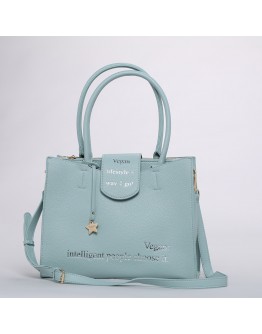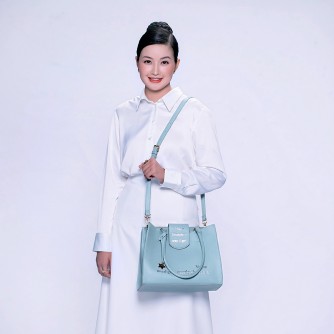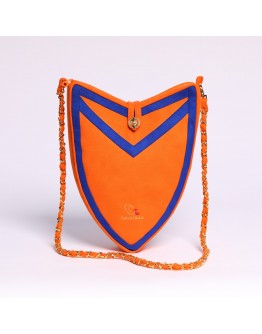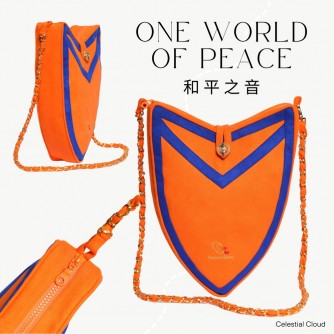
Embracing Our Planet, One Stitch at a Time, with Cruelty-Free Vegan Leather
In the dazzling world of fashion, the constant cycle of trends on runways and new designs in shop windows perpetually captivates our attention. Yet, behind this beautiful facade, the traditional fashion industry's impact on environmental and animal welfare has become a critical global concern. Fortunately, a powerful wave of Sustainable Fashion is rising—not merely as a trend, but as a responsible choice for our future. For fashion enthusiasts who seek unique styles while deeply caring for our planet, this movement brings exciting possibilities, especially through material innovation. Among these, Vegan Leather is playing a pivotal role, guiding us towards a kinder, greener, and more conscious fashion future.
2. Welcoming a Green Future: The Rise, Types, and Innovative Applications of Vegan Leather
3. Expanding the Sustainable Landscape: Eco-Friendly Faux Fur & Circular Economy Fashion Practices
4. Zero Waste Design: Minimizing Waste from the Source, Valuing Every Inch of Fabric
5. How to Embark on Your Sustainable Fashion Journey: Becoming a Conscious Fashion Player
6. Conclusion: Partnering with Vegan Leather for a Sustainable Fashion Future

Why Do We Need Sustainable Fashion?
Let’s look at some of the dire consequences of the current fashion industry.
The Environmental Cost of “Fast Fashion”
"Fast Fashion," with its rapid production cycles, low prices, and trend-chasing nature, has dominated consumer markets for decades. However, this model of high consumer consumption has wreaked havoc on the environment. From the vast amounts of water and pesticides required for cotton cultivation to the pollution of waterways by chemical dyes, and the pressure on landfills from discarded garments, the fashion industry has become the world's second-largest polluter, second only to the oil industry [1]. Mass-produced, inexpensive clothing often lacks quality, leading to a short lifespan and quick disposal, further exacerbating the environmental burden. Choosing sustainable fashion is an active response to this pressing issue.
Ethical Controversies & Environmental Impact of Traditional Leather & Fur
Beyond environmental concerns, the production of traditional animal leather and fur products raises profound ethical questions. Billions of animals are farmed and slaughtered annually for their skins. This process consumes vast amounts of land, water, and feed, while also generating significant greenhouse gas emissions. The tanning process for leather often uses heavy metals like chromium, which not only endangers workers' health but also contaminates soil and water sources [2]. The inherent cruelty of the fur industry is even more widely recognized. An increasing number of conscientious consumers and designers are rejecting fur products because of the immense suffering inflicted on fur-bearing animals. This underscores the critical importance of finding alternatives such as vegan leather and eco-friendly faux fur.
Welcoming a Green Future: The Rise, Types, and Innovative Applications of Vegan Leather
Confronted with the environmental and ethical dilemmas posed by traditional materials, vegan leather has emerged as a key "man-made leather alternative," rapidly gaining prominence in the Green Fashion landscape.
What is Vegan Leather?
Broadly defined, vegan leather encompasses all man-made leathers that contain no animal components. In its earlier forms, plastic-based materials were most common:
PU (Polyurethane) Leather: Compared to PVC, PU is generally softer, more breathable, and its production typically involves fewer harmful substances, making it a more mainstream "eco-friendlier artificial leather" choice currently.
PVC (Polyvinyl Chloride) Leather: While durable and inexpensive, its production and disposal can release harmful substances like dioxins, posing a greater environmental risk. It is gradually being replaced by more eco-conscious options.
However, true innovation has stemmed from the burgeoning field of Plant-based Vegan Leather:
Pineapple Leaf Leather (Piñatex®): Crafted from the waste fibers of pineapple leaves after harvest, transforming agricultural byproducts into a unique, textured leather alternative [3].
Mushroom Leather (Mylo™, Reishi™): Cultivated from the mycelium (root structure) of mushrooms in a lab environment. It grows quickly, requires little water, and offers a soft texture with a biodegradable potential [4].
Apple Leather (AppleSkin™): Made from the residual pulp and peel from the apple juicing industry, combined with PU, effectively upcycling food industry waste.
Cactus Leather (Desserto®): Derived from organically grown Nopal cacti, which require minimal water. The resulting leather is soft, durable, and partially biodegradable [5].
Other Innovations: Corn, grape skins, mangoes, and even algae are inspiring scientists and designers to develop next-generation vegan leathers, infusing sustainable fashion with even more possibilities.

Why Choose Vegan Leather?
Vegan leather is Cruelty-Free: It completely avoids harm and exploitation of animals, satisfying ethical consumer demands.
Vegan leather has a Lower Environmental Footprint: Relative to the immense resources consumed and emissions produced by animal agriculture, and the polluting processes of traditional leather tanning, many vegan leathers (especially plant-based ones) have a significantly reduced environmental impact. For instance, Piñatex® utilizes agricultural waste that would otherwise have to be burned or left to decay.
Innovation & Style: New types of vegan leather offer unique textures, tactile qualities, and appearances, providing designers with a broader creative canvas and satisfying fashion lovers' desires for novel designs. Many vegan leather bags and shoes have already become trend-setting items.
Improved Performance: With technological advancements, high-quality vegan leathers can now match or even surpass traditional leather in durability, water resistance, and breathability, dismantling the old stereotype of "artificial leather = cheap and non-durable."

Expanding the Sustainable Landscape: Eco-Friendly Faux Fur & Circular Economy Fashion Practices
The practice of sustainable fashion extends beyond vegan leather to encompass other materials and design philosophies.
Eco-Friendly Faux Fur: Warmth and Style Without Animal Sacrifice.
For consumers seeking luxury and warmth, eco-friendly faux fur offers an excellent alternative. Modern faux fur technology can produce materials that are remarkably realistic in texture, incredibly soft to the touch, and often even lighter and warmer than real fur. Many brands (like rPET) are now using recycled plastic bottles as raw material for faux fur, further reducing reliance on virgin resources and mitigating plastic waste [6]. Choosing high-quality, eco-friendly faux fur allows one to satisfy fashion desires while upholding the principle of not harming animals—a truly sustainable choice for colder seasons.

Circular Economy Fashion: Keeping Resources in a Closed Loop Circular
Circular Economy Fashion represents a more holistic, sustainable strategy. It aims to break the traditional linear "make-use-dispose" model by establishing a "fashion ecosystem" where resources are kept in continuous circulation.
Designing for Durability: Considering a garment's longevity and reparability from the initial design phase, encouraging consumers to extend the life of their clothing.
Recycling & Regeneration: Developing clothing that is easy to disassemble and recycle, and repurposing recovered materials (like textile waste or plastic bottles) into new yarns and fabrics.
Upcycling: Transforming waste materials or old garments into new products of higher value, giving them a second life.
Renting & Second-hand: Promoting clothing rental platforms and the second-hand fashion market to reduce unnecessary purchases and increase garment utilization rates.
Zero Waste Design: Minimizing Waste from the Source, Valuing Every Inch of Fabric
Zero Waste Design is a technique applied during the pattern-making and cutting stages of garment production to minimize fabric waste. In traditional apparel manufacturing, approximately 15-20% of fabric becomes scrap and is discarded [7]. Zero-waste designers, however, utilize clever pattern engineering, tessellation, draping, or knitting techniques to incorporate virtually every inch of fabric into the final garment, embodying resource conservation from the outset and demonstrating profound respect for materials.
How to Embark on Your Sustainable Fashion Journey: Becoming a Conscious Fashion Player
Embracing sustainable fashion begins with our everyday choices:
Become a Conscious Consumer: Smart Purchases, Support Sustainable Brands
Quality over Quantity: Invest in high-quality, timeless, and durable pieces rather than chasing fleeting trends.
Research the Brands: Understand a brand's sustainability policies. Choose those that are transparent and actively practice environmental and social responsibility. Look for relevant certifications like GOTS (Global Organic Textile Standard), Fair Trade, or B Corp.
Know Your Materials: Pay attention to garment labels. Prioritize materials like organic cotton, linen, Tencel™, recycled fibers, and high-quality vegan leathers and eco-friendly faux furs. Understand the characteristics and pros/cons of different vegan leather types.
Cherish and Extend Garment Lifespan: Practice the Spirit of Slow Fashion
Proper Care: Follow washing instructions, reduce washing frequency when possible, and opt for air drying to extend garment life and save energy.
Learn to Mend: Simple sewing skills can give slightly damaged clothes a new lease on life.
Creative Alterations: For clothes that no longer fit or feel outdated, try creatively altering them to give them a fresh look.
Embrace Diverse Ways of Dressing: Explore Second-hand and Rental Possibilities
Discover Second-hand Treasures: Thrift stores, online resale platforms, and clothing swap events are excellent places to find unique and eco-friendly items.
Try Clothing Rentals: For special occasions or items you'd only wear infrequently, renting is a smart and environmentally sound option.
Conclusion: Partnering with Vegan Leather for a Sustainable Fashion Future
Sustainable fashion is not a distant slogan but a revolution happening now. From the innovation in vegan leathers and the popularization of eco-friendly faux fur to the promotion of circular economy principles and zero-waste design, the fashion industry is steadily moving toward a more responsible and conscious paradigm.
As consumers, every choice we make holds power. When we opt for a bag made from innovative plant-based vegan leather or a jacket crafted from recycled materials, we are showing our profound respect for our planet and all living beings. Let us together embrace green fashion, support brands that utilize vegan leather, and use our wisdom and conscience to style a sustainable identity, collectively weaving a more beautiful and compassionate future.

Source:
[1]: United Nations Environment Programme (UNEP). "Putting the Brakes on Fast Fashion."
[2]: PETA. "The Environmental Impact of Leather."
[3]: Ananas Anam (Piñatex®). "Our Material."
[4]: Bolt Threads (Mylo™). "The Material."
[5]: Adriano Di Marti (Desserto®). "About Us."
[6]: Humane Society International. "Faux Fur: The Sustainable Choice."
[7]: Fashion Revolution. "Zero Waste Fashion."
Related products
PRODUCT DETAILS Stock ID: A6704 Name: Vegan Slogan "intelligent people choose it" Handbag Crossbody Shoulder Bag Slogans: Vegan lifestyle = way 2 go! Vegan: intelligent people choose it. Material: 100% PU (Artificial leather) Size: Width 31cm, Height 24cm, Side Thickness 14cm CARING PU leather maintenance: ● Do not wash or dry clean. If the handbag needs cleaning, wipe the surface gently with a slightly damp soft cloth, and place it in a cool place to air dry. ● Do not wipe with volatile liquids, such as alcohol, chemical detergent, etc., to avoid chemical changes to the vegan leather. ● When not in use, place handbag in a dustproof bag and avoid direct contact with moisture. COLOR DISCLAIMER Product pictures are taken of the actual product. There may be slight color differences between the photos and the actual product due to the lighting sources and how they are displayed by your monitor or device. Supreme Master Ching Hai has created a magnificent series of slogan-decorated garments & accessories for the vegan Golden Era. The slogans help to awaken people’s innate benevolent and loving nature, thus opening the Great Gate to a peaceful vegan world! Noble, elegant, practical and versatile design. 100% environmentally friendly PU artificial leather. Adds beauty and elegance to your peaceful, vegan life. Turn love into action and become a true vegan hero! ..
Add to CartPRODUCT DETAILS Stock ID: A0930 Name: One World of Peace Material: Outer/Inner - polyester Size (cm): width - 22, height - 27, depth - 6 CARING - Washable, water temperature below 40℃. - Use neutral detergents. - Can spin dry. - Do not bleach. - Do not tumble dry. PURCHASE NOTE *Please contact customer service before placing an order. *No returns or exchanges. In the 1990s, Supreme Master Ching Hai designed colorful and beautiful celestial bags. At that time, most of the leather bags on the market were made of animal leather, and adopted the design of dark colors, such as gray, black and coffee. In order to reveal that everyone has a kind, beautiful and glorious heavenly quality inside, Supreme Master Ching Hai has designed exquisite and elegant celestial bags using benevolent vegan artificial suede material with perfect and splendid color matching. This novel design has led to a new atmosphere in the fashion world! Since then, the market has in succession launched bags with bright colors and benevolent ideas. Supreme Master Ching Hai's brilliant fashion design combines the noble concept of environmental protection and life caring to make the world more beautiful and lead the world into the golden age! ..
Add to Cart





